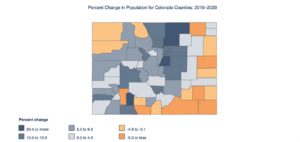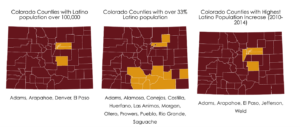Blog Post
Get To Know Colorado’s Newest Congressional District
When Coloradans head to the polls this November, we will be voting to send eight representatives to Congress — up from seven since 2010. That’s because we gained an eighth congressional seat as a result of our growing population, reflected in the once-a-decade Census count in 2020. A new member of Congress means Colorado’s voice in Congress is even stronger with eight members there to vote on issues on our behalf.
And while this election might seem like any other, it’s the product of years of work to ensure we the voters can choose our leaders in elections that require candidates to actually compete for our vote. Here’s how we got here.
Census Count 2020
Each decade, Colorado and every state and territory in America participates in the Census Count. Just like it sounds, it’s a process to literally count every single American to determine congressional representation and federal funding for every state and territory for the next 10 years.
Federal funding for community resources like schools, roads, and healthcare is finite. The number of members of Congress is locked in at 435. Given this fact, there must be a mechanism to distribute that funding as fairly as possible.
The Census count helps ensure federal funding and representation keeps up with a growing and changing population. While some states may see a surge in population growth over a period of time, other states may see steep declines. That means as populations change, so too must federal dollars for community resources and congressional representation.
The founding fathers understood this and recognized the need for government to keep up with the shifting demographics of the country in the future. That’s why they mandated a decennial Census count as part of the U.S. Constitution.
And so, in April 2020, despite many issues from meddling by the former president to the COVID-19 pandemic, Colorado and the entire country undertook a major effort to make sure each and every one of our family members, neighbors, co-workers, and friends were counted in the 2020 Census.

Source: U.S. Census Bureau
The good news is Colorado is among the “fastest growing states” in the last decade. We were one of 13 states and the District of Columbia that grew by 10% or more since 2000, the last time we were counted in a Census. Colorado’s population actually grew by 14%, which is how we earned an additional congressional district.
Much of our state’s growth is driven by communities of color, “contributing to the country’s Latino boom.” In fact, the Latino population growth in Colorado doubled that of the rest of the country. Nationally, the Hispanic and Latino population grew 23%, but in Fort Collins, the population grew 41%.
With greater population numbers, and the reason for an additional Congressional seat, Latino voters should rightfully have greater political power than in the last decade, or so one would think.

Source: Latino Leadership Institute
Congressional District 8
Colorado’s explosive population growth helped secure a brand-new congressional district: District 8. Until now, we’ve only had seven members of Congress to represent us in Washington. After the upcoming 2022 election, we’ll have eight members of Congress to be our voice on the major issues of the day.
This development is huge for Colorado, especially as many states — California, Ohio, and New York — lost Congressional seats.
The new district runs from the northeast Denver suburbs of Commerce City, Northglenn, and Thornton through Brighton all the way to Greeley. This area accounts for a lot of Colorado’s population growth in the last decade, so Commissioners on the Independent Redistricting Commission felt it was the right spot for the new district.
CD 8 has the most diverse population of Colorado’s Congressional districts with only 51.7% identifying as white and 38.5% identifying as Hispanic or Latino. It is also the state’s most competitive district with 44 percent of voters unaffiliated with a party and 28 percent registered as democrats and 25 percent registered as republicans.
During the redistricting process, Colorado Common Cause urged the Commission to draw a district that maximized the political power of BIPOC communities, especially the Hispanic/Latino community which makes up almost a quarter of our state’s population. While we don’t think CD 8 accomplished this, it is critical that voters make their voices heard both in the June primary and the November General election.
With such a competitive district, candidates in CD 8 need to be acutely aware and tuned in to the needs and issues most important to CD 8 voters and every vote will be important in determining who Colorado’s newest Congressperson will be!
Redistricting
With a new Census count each decade also comes the once-a-decade redistricting process. The U.S. Constitution requires states and localities to draw new voting districts at every level of government after each census to ensure that districts of the same type have an approximately equal number of residents. Although that process is essential to ensuring equal representation, it has often been used to manipulate boundaries and give one political party an advantage, to protect incumbents, discriminate against people of color, or simply to exact political punishment against a person or community.
For decades, Colorado empowered self-interested legislators or a commission appointed directly by politicians to draw districts. After the last round of redistricting in Colorado resulted in bitter partisan infighting, Coloradans sought a new approach. Thanks to the pressure Colorado Common Cause and our reform allies exerted on legislators, the General Assembly put Amendments Y and Z on the 2018 ballot to create new independent redistricting commissions – one to draw U.S. House districts and another to draw Colorado General Assembly districts. Voters approved both measures with 71% of the vote. The commission rules mandated partisan balance and public participation while prohibiting a long list of political insiders from being a commissioner. This redistricting cycle, Colorado Common Cause went around the state to gather input from ordinary Coloradans about what a map with fair representation might look like and proposed U.S. House and General Assembly maps to the commission. We also with the Colorado Supreme Court during the court’s mandatory review of the Congressional Commission’s map. Although the final maps might not have been exactly what we would have drawn, the process was more transparent, less partisan, and involved greater public participation than would have happened with politicians in charge.
That’s how we arrived at a new 8th Congressional District and the districts Coloradans will vote in for the next decade. We urge you to participate in the upcoming June 28 primary to make your voices heard in our democracy.